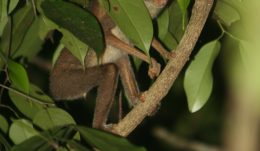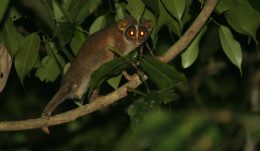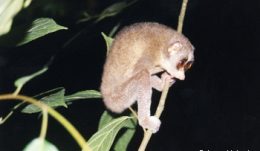- Locations: Sri Lanka
- Active dates: 2009 - 2015
Aims
1. To verify the distribution, range habitat and monitoring. 2. Clarify the taxonomy of red slender lorises 3. Create awareness programmes and capacity building in management agencies 4. Create a conservation action plan for slender loris conservation in Sri Lanka
Species
Background
Reliable data on occurrence and extent of the slender loris complex appears very limited despite a decade of research engagement.
Conservation management demands more reliable and systematic survey to verify the distribution boundaries of the slender loris complex for the identification of spatial conservation units. In addition, robust trend data capable of demonstrating changes in species circumstances is an essential component to any competent species conservation management plan. Loris habitat use and preference is also still ill-defined for certain critical ecotypes such as home gardens and montane forest. A well designed monitoring programme which focuses primarily on repeat surveys recording presence or absence should be able to deliver robust baseline data.
Species and subspecies boundaries remain confused within the Loris tardigradus complex and Sri Lankan researchers suggest that cryptic taxa may be included within the current four described subspecies due to regionally specific polymorphisms observed. It has been suggested that L.t.nycticeboides may be distinct species in its own right and if this is the case then this species is likely to be considered critically endangered, and requiring of further conservation attention.
Awareness programmes were be conducted where the opportunity arises during the field programme to advocate the conservation of slender loris and habitat. This was conducted through community workshops, school education programmes, and close involvement with local schools and science/environmental education teachers. A focused effort was also be made to achieve greater understanding of loris biology, ecology and conservation need amongst DWC and DF planning and field staff.
We delivered a conservation action plan (CAP) for the red slender loris by the end of this programme that initiated the formation of a species management and/or recovery programme for some or all of the taxa involved.
Gallery



Achievements
The establishment of a national association of experts and authorities, with the primary objective of determining priority action areas for research, conservation and education.
Rediscovery of the virtually unknown Horton Plains slender loris (Loris tardigradus nycticeboides). Originally documented in 1937, there have only been four known encounters in the past 72 years. The rediscovery and capture by the team (working under the ZSL EDGE programme) has resulted in the first detailed physical examination of this sub-species.
The Horton Plains slender loris is evidently extremely rare and was only found after more than 200 hours of nocturnal transect surveys in the known habitat. The red slender loris is a focal EDGE species, and the rarity of L. t. nycticeboides resulted in it being listed as one of the world’s 25 most endangered primates.
Related blog posts

News from the field: Slender loris surveys underway
One of our EDGE Fellows, Vijitha Perera, started fieldwork in March on the red slender loris (Loris tardigradus) in the Knuckles Range, Sri Lanka….